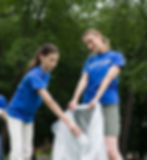Using Their Powers for Good: Community Engagement for the Upper El Classroom

They're taller. They talk a lot. They prefer the company of their friends over their parents. They are convinced that the world would be a much much better place if people would start consulting them before they made major decisions (and, truth be told, they're probably right.) They're Upper Elementary learners, and they're ready to engage.
How can we support the natural tendencies of Upper Elementary students? First we need to know what they are. The window from 6-12, or the Second Plane of Development, is a growth of imagination. I don't mean that just in the amount of original or creative work that tends to emerge at this period, but specifically that the child is cognitively capable of imagining things that are not within his environment in great detail, of thinking through cause and effect, of understanding wide-ranging abstract relationships and of imagining the world as an interdependent web within which all those concepts mingle and dance. The period from 6 to 9 is often driven by a desire for more details: specific details about societies, children, governments, locations, history, and the like. The period from 9 to 12 revels in this new knowledge and wants to make use of it. Understanding that government exists, these learners want to influence policy making. Understanding disparities between communities, these learners want to work to change them.
In the classroom, you'll see children in this plane offered the Great Lessons, epic narratives that describe the interdependence of the universe. These stories offer sufficient detail to satisfy children's curiosity, and enough mythic scope to inspire their imaginations. And each emphasizes the role of humans as stewards and caretakers. This is a great time to introduce student-driven service projects, both in their classrooms and outside, in the larger school community and in the neighborhoods around school. This can sometimes feel daunting, but with careful planning, can offer profoundly meaningful learning for upper elementary aged learners.
Remember to start with the children: Rather than identifying a program or need on your own, ask the children what problems they see in their classroom that they'd like to address. In a community meeting, remind the children that you know them to be thoughtful observers and that you want to discuss ways in which they may be of better service to each other in the classroom. Let them identify the areas for support, and then work with them (and within your knowledge of your classroom's capacity!) to narrow down their ideas to actions. Maybe they notice that they are using a lot of paper but don't have a manageable recycling program. Maybe they see that they are creating a lot of trash at lunchtime and want to reduce their waste. Together, you can brainstorm interventions for your classroom.
Once you've practiced being of service in your classroom, expand the field to the rest of the school. This may happen quite quickly, since children at this age are able to generalize lessons more rapidly than they were when they were younger. Ask them if they have observed any spaces in their school community to which they could be of service. Maybe they know the Primary teachers get overwhelmed by laundry. Maybe they've seen younger children who have a hard time waiting at carline. Maybe they see the ways in which the office staff sometime are interrupted by their work to bring messages to the classrooms. With a little prompting, they can articulate ways in which they can take responsibility for other parts of their school community.
Let them think beyond their borders: Offer service projects as an extended work on the shelf, including organizational structures for identifying a project, thinking through their contribution, contacting stakeholders, being of service and assessing their work. While "one-and-done" service can be a great way of getting off campus and building memories with your class, extended service projects that allow students to research advocate organizations, or see the culmination of a lot of little steps along the way, are very well-suited to learners at this age.
Constantly assess: Whether you're supporting service within your classroom or beyond your national boundaries, check in regularly with the children involved to see how the experience is different than they may have expected, to discern how effective their efforts have been, and to help them adjust the systems they want to implement to affect change.
Remember, while children at this stage are motivated to contribute, they still need your support to learn how to do so successfully. Think of your role as a consulting adult, available to brainstorm and help predict trouble spots or to prompt thinking about the impact and effectiveness of the service, but let the problems and the potential for solution come from the learners themselves. From implementing a recycling program to clearing walking paths on your school property, from reading to younger children or volunteering in the nursery at a local adult education program, children in the second plane of development are capable contributors. Make room for them, and they'll change the world.
